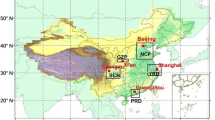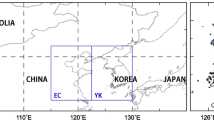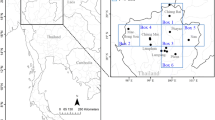Abstract
Different spatio-temporal variations and trends in column aerosol optical depth (AOD) and surface particulate matter (PM10; diameter < 10 μm) mass concentration were found for selected regions of East Asia. Enhanced AOD over North China and its downwind regions (Yellow Sea, Korea) occurred in June, compared with March–April over South China. Increased PM10 concentration in both North and South China was observed from late fall to spring. In Northeast China, a peak in AOD appeared during March, but high PM10 concentrations occurred in December–January. A significantly increasing trend in AOD was found in North and Northeast China, whereas surface PM10 concentrations over most megacities in these two regions declined almost linearly. This contradictory trend between AOD and PM10 concentration can be attributed to large emissions reductions in near-surface coarse particles, mainly accredited to a series of strict control measures. In other words, there has been no meaningful reduction in fine-mode particles including secondary aerosols. On the other hand, space-based CALIOP measurements revealed that approximately 60~70% (40~50%) of AOD was contributed by the aerosols present above 1 km (above 2 km) altitude. Our findings suggest that stronger emission controls for precursor gaseous emissions as well as submicron particles are required to decrease particulate air pollution, so as to further reduce their radiative forcing.







Similar content being viewed by others
References
Awan JA, Bae DH, Kim KJ (2015) Identification and trend analysis of homogeneous rainfall zones over the East Asia monsoon region. Int J Climatol 35:1422–1433
Cai W, Li K, Liao H, Wang H, Wu L (2017) Weather conditions conducive to Beijing severe haze more frequent under climate change. Nat Clim Chang 7:257–262
Chan CK, Yao XH (2008) Air pollution in mega cities in China. Atmos Environ 42:1–42
Cheng Z, Jiang JK, Fajardo O, Wang SX, Hao JM (2013) Characteristics and health impacts of particulate matter pollution in China (2001–2011). Atmos Environ 65:186–194. https://doi.org/10.1016/j.atmosenv.2012.10.022
Chew BN, Campbell JR, Hyer EJ, Salinas SV, Reid JS, Welton EJ, Holben BN, Liew SC (2016) Relationship between aerosol optical depth and particulate matter over Singapore: effects of aerosol vertical distributions. Aerosol Air Qual Res 16:2818–2830
Collaud Coen M, Andrews E, Asmi A, Baltensperger U, Bukowiecki N, Day D, Fiebig M, Fjaeraa AM, Flentje H, Hyvärinen A, Jefferso A, Jennings SG, Kouvarakis G, Lihavainen H, Lung Myhre C, Malm WC, Mihapopoulous N, Molenar JV, O’Dowd C, Ogren JA, Schichtel BA, Sheridan P, Virkkula A, Weingartner E, Weller R, Laj P (2013) Aerosol decadal trends–part 1: in-situ optical measurements at GAW and IMPROVE stations. Atmos Chem Phys 13:869–894
Cottle P, Strawbridge K, McKendry I (2014) Long-range transport of Siberian wildfire smoke to British Columbia: Lidar observations and air quality impacts. Atmos Environ 90:71–77
Duan A, Wang M, Lei Y, Cui Y (2013) Trends in summer rainfall over China associated with the Tibetan Plateau sensible heat source during 1980–2008. J Clim 26:261–275. https://doi.org/10.1175/jcli-d-11-00669.1
Engel-Cox JA, Hoff RM, Rogers R, Dimmick F, Rush AC, Szykman JJ, Al-Saadi J, Chu DA, Zell ER (2006) Integrating lidar and satellite optical depth with ambient monitoring for 3-dimensional particulate characterization. Atmos Environ 40:8056–8067
Kim S-W, Yoon SC, Kim J, Kim S-Y (2007) Seasonal and monthly variations of columnar aerosol optical properties over east Asia determined from multi-year MODIS, LIDAR, and AERONET sun/sky radiometer measurements. Atmos Environ 41:1634–1651
Kim S-W, Yoon SC, Kim J (2008) Columnar Asian dust particle properties observed by sun/sky radiometers from 2000 to 2006 in Korea. Atmos Environ 42:492–504
Kim HS, Chung YS, Yoon MB (2016) An analysis on the impact of large-scale transports of dust pollution on air quality in East Asia as observed in central Korea in 2014. Air Qual Atmos Health 9:83–93
Lalitaporn P, Kurata G, Matsuoka Y, Thongboonchoo N, Surapipith V (2013) Long-term analysis of NO2, CO, and AOD seasonal variability using satellite observations over Asia and intercomparison with emission inventories and model. Air Qual Atmos Health 6(4):655–672
Lang J, Zhang Y, Zhou Y, Cheng S, Chen D, Guo X, Chen S, Li X, Xing X, Wang H (2017) Trends of PM2.5 and chemical composition in Beijing, 2000–2015. Aerosol Air Qual Res 17:412–425
Levy RC, Mattoo S, Munchak LA, Remer LA, Sayer AM, Patadia F, Hsu NC (2013) The collection 6 MODIS aerosol products over land and ocean. Atmos Meas Technol 6:2989–3034
Liu Q, Baumgartner J, Zhang Y, Schauer JJ (2016) Source apportionment of Beijing air pollution during a severe winter haze event and associated pro-inflammatory responses in lung epithelial cells. Atmos Environ 126:28–35
Logan T, Xi B, Dong X, Li Z, Cribb M (2013) Classification and investigation of Asian aerosol absorptive properties. Atmos Chem Phys 13:2253–2265
Lu W, Yang L, Chen J, Wang X, Li H, Zhu Y, Wen L, Xu C, Zhang J, Zhu T, Wang W (2016) Identification of concentrations and sources of PM2. 5-bound PAHs in North China during haze episodes in 2013. Air Qual Atmos Health 9:823–833
Lv B, Hu Y, Chang HH, Russell AG, Bai Y (2016) Improving the accuracy of daily PM2.5 distributions derived from the fusion of ground-level measurements with aerosol optical depth observations, a case study in North China. Environ Sci Technol 50:4752–4759
Ma Z, Hu X, Huang L, Bi J, Liu Y (2014) Estimating ground-level PM2.5 in China using satellite remote sensing. Environ Sci Technol 48:7436–7444
Mehta S, Shin H, Burnett R, North T, Cohen AJ (2013) Ambient particulate air pollution and acute lower respiratory infections: a systematic review and implications for estimating the global burden of disease. Air Qual Atmos Health 6:69–83
Nguyen DL, Kim JY, Ghim YS, Shim SG (2015) Influence of regional biomass burning on the highly elevated organic carbon concentrations observed at Gosan, South Korea during a strong Asian dust period. Environ Sci Pollut Res 22:3594–3605
O’Neill MS, Breton CV, Devlin RB, Utell MJ (2012) Air pollution and health: emerging information on susceptible populations. Air Qual Atmos Health 5:189–201
Oberdörster G, Oberdörster E, Oberdörster J (2005) Nanotoxicology: an emerging discipline evolving from studies of ultrafine particles. Environ Health Perspect 113:823–839
Peel JL, Haeuber R, Garcia V, Russell AG, Neas L (2013) Impact of nitrogen and climate change interactions on ambient air pollution and human health. Biogeochemistry 114:121–134
Pozzer A, de Meij A, Yoon J, Tost H, Georgoulias AK, Astitha M (2015) AOD trends during 2001-2010 from observations and model simulations. Atmos Chem Phys 15:5521–5535
Qu WJ, Arimoto R, Zhang XY, Zhao CH, Wang YQ, Sheng LF, Fu G (2010) Spatial distribution and interannual variation of surface PM10 concentrations over eighty-six Chinese cities. Atmos Chem Phys 10:5641–5662. https://doi.org/10.5194/acp-10- 5641-2010
Remer LA, Kaufman YJ, Tanre D, Mattoo S, Chu DA, Martins JV, Li RR, Ichoku C, Levy RC, Kleidman RG, Eck TF, Vermote E, Holben BN (2005) The MODIS aerosol algorithm, products, and validation. J Atmos Sci 62:947–973. https://doi.org/10.1175/JAS3385.1
Schulz M, Textor C, Kinne S, Balkanski Y, Bauer S, Berntsen T, Berglen T, Boucher O, Dentener F, Guibert S, Isaksen ISA, Iversen T, Koch D, Kirkevåg A, Liu X, Montanaro V, Myhre G, Penner JE, Pitari G, Reddy S, Seland Ø, Stier P, Takemura T (2006) Radiative forcing by aerosols as derived from the AeroCom present-day and pre-industrial simulations. Atmos Chem Phys 6:5225–5246
Seinfeld JH, Pandis SN, Noone K (1998) Atmospheric chemistry and physics: from air pollution to climate change. Wiley-Interscience Publication, Hoboken
Seo S, Kim J, Lee H, Jeong U, Kim W, Holben BN, Kim S-W, Song CH, Lim JH (2015) Estimation of PM10 concentrations over Seoul using multiple empirical models with AERONET and MODIS data collected during the DRAGON-Asia campaign. Atmos Chem Phys 15:319–334
Shao Y, Dong CH (2006) A review of East Asian dust storm climate, modelling and monitoring. Glob Planet Chang 52:1–22
Shindell DT, Lamarque J-F, Schulz M, Flanner M, Jiao C, Chin M, Young PJ, Lee YH, Rotstayn L, Mahowald N, Milly G, Faluvegi G, Balkanski Y, Collins WJ, Conley AJ, Dalsoren S, Easter R, Ghan S, Horowitz L, Liu X, Myhre G, Nagashima T, Naik V, Rumbold ST, Skeie R, Sudo K, Szopa S, Takemura T, Voulgarakis A, Yoon J-H, Lo F (2013) Radiative forcing in the ACCMIP historical and future climate simulations. Atmos Chem Phys 13:2939–2974
Streets DG, Yan R, Chin M, Diehl T, Mahowald N, Schultz M, Wild M, Wu Y, Yu C (2009) Anthropogenic and natural contributions to regional trends in aerosol optical depth, 1980-2006. J Geophys Res 114(D10).doi:https://doi.org/10.1029/2008JD011624
Tiao GC, Reinsel GC, Xu D, Pedrick JH, Zhu X, Mler AJ, DeLuisi JJ, Mateer CL, Wuebbles DJ (1990) Effects of autocorrelation and temporal sampling schemes on estimates of trend and spatial correlation. J Geophys Res 95(D12)
van der Werf GR, Randerson JT, Giglio L, Collatz GJ, Mu M, Kasibhatla PS, Morton DC, DeFries RS, Jin Y, van Leeuwen TT (2010) Global fire emissions and the contribution of deforestation, savanna, forest, agricultural, and peat fires (1997–2009). Atmos Chem Phys 10:11707–11735. https://doi.org/10.5194/acp-10-11707-2010
Wang H-J, Chen H-P (2016) Understanding the recent trend of haze pollution in eastern China: roles of climate change. Atmos Chem Phys 16:4205–4211. https://doi.org/10.5194/acp-16-4205-2016
Wang Y, Zhuang G, Tang A, Yuan H, Sun Y, Chen S, Zheng A (2005) The ion chemistry and the source of PM2.5 aerosol in Beijing. Atmos Environ 39:3771–3784
Wang SX, Zhao B, Cai SY, Klimont Z, Nielsen CP, Morikawa T, Woo JH, Kim Y, Fu X, Xu JY, Hao JM, He KB (2014) Emission trends and mitigation options for air pollutants in East Asia. Atmos Chem Phys 14:6571–6603
Weatherhead EC, Reinsel GC, Tiao GC, Meng X-L, Choi D, Cheang W-K, Keller T, DeLuisi J, Wuebbles DJ, Kerr JB, Miller AJ, Oltmans SJ, Frederick JE (1998) Factors affecting the detection of trends: statistical considerations and applications to environmental data. J Geophys Res 103:17149–17161. https://doi.org/10.1029/98JD00995
Xie Y, Bin Z, Lin Z, Rong L (2015) Spatiotemporal variations of PM2.5 and PM10 concentrations between 31 Chinese cities and their relationships with SO2, NO2, CO and O3. Particuology 20:141–149
Yin D, Zhao S, Qu J (2017) Spatial and seasonal variations of gaseous and particulate matter pollutants in 31 provincial capital cities, China. Air Qual Atmos Health 10:359–370
You W, Zang Z, Zhang L, Li Z, Chen D, Zhang G (2015) Estimating ground-level PM10 concentration in northwestern China using geographically weighted regression based on satellite AOD combined with CALIPSO and MODIS fire count. Remote Sens Environ 168:276–285
Yu X, Zhu B, Yin Y, Yang J, Li Y, Bu X (2011) A comparative analysis of aerosol properties in dust and haze-fog days in a Chinese urban region. Atmos Res 99:241–247
Zhang J, Reid JS (2010) A decadal regional and global trend analysis of the aerosol optical depth using a data-assimilation grade over-water MODIS and level 2 MISR aerosol products. Atmos Chem Phys 10:10949–10963
Zhang XY, Gong SL, Shen ZX, Mei FM, Xi XX, Liu LC, Zhou ZJ, Wang D, Wang YQ, Cheng Y (2003) Characterization of soil dust aerosol in China and its transport/distribution during 2001 ACE-Asia:1. Network observations. J Geophys Res 108(D9):4261
Zhang X, Wang L, Wang W, Cao D, Wang X, Ye D (2015) Long-term trend and spatiotemporal variations of haze over China by satellite observations from 1979 to 2013. Atmos Environ 119:362–373
Zheng S, Pozzer A, Cao CX, Lelieveld J (2015) Long-term (2001–2012) concentrations of fine particulate matter (PM2.5) and the impact on human health in Beijing, China. Atmos Chem Phys 15:5715–5725
Acknowledgements
We thank the principle investigators at Aerosol Robotic Network (AERONET) and the Moderate Resolution Imaging Spectroradiometer (MODIS) and Cloud-Aerosol Lidar and Infrared Pathfinder Satellite Observations (CALIPSO) project offices for enabling easy access to the data.
Funding
This study was supported by the Korean Meteorological Administration (KMA) Research and Development Program under Grant KMIPA 2015-2011 and the Korean Ministry of Environment as “Climate Change Correspondence”.
Author information
Authors and Affiliations
Corresponding author
Electronic supplementary material
ESM 1
(PDF 2.65 mb).
Rights and permissions
About this article
Cite this article
Nam, J., Kim, SW., Park, R.J. et al. Changes in column aerosol optical depth and ground-level particulate matter concentration over East Asia. Air Qual Atmos Health 11, 49–60 (2018). https://doi.org/10.1007/s11869-017-0517-5
Received:
Accepted:
Published:
Issue Date:
DOI: https://doi.org/10.1007/s11869-017-0517-5




